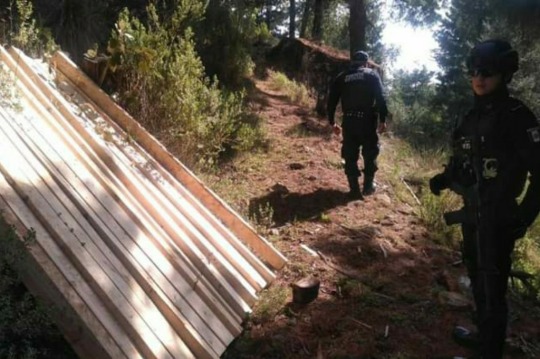#Cofre de Perote
Text
Espectacular Luna


12 notes
·
View notes
Text
Explora el Cofre de Perote
¡Prepárate para una experiencia inolvidable explorando el imponente Cofre de Perote en un día lleno de descubrimientos! Los próximos 14 y 28 de enero, así como el 4 de febrero, te invitamos a un viaje desde Veracruz, Cardel y Xalapa para sumergirte en la belleza natural y la historia de esta emblemática montaña.
Excursión Al Cofre de Perote Saliendo de Veracruz, Cardel y Xalapa
1. El Cofre de…

View On WordPress
0 notes
Text
¡Siguen matando al Cofre!
Habitantes del Predio Las Palomas de Perote denunciaron la tala ilegal de árboles.
Eduardo Duran Ortega, Guarda bosques y productor de árboles, hizo un llamado a las autoridades estatales y de la Comisión Nacional Forestal para que intervengan en la zona y detengan la tala clandestina.
El entrevistado señaló que están afectando severamente las plantaciones e incluso ocasionaron un incendio en…

View On WordPress
1 note
·
View note
Text


Cofre de Perote Salamander (Isthmura naucampatepetl), family Plethodontidae, Veracruz, Mexico
CRITICALLY ENDANGERED.
This species was first described in 2001, and since then only a few live specimens have been found.
The area of Mexico where they live has experienced widespread habitat disturbance from logging, farming, and settlement.
photograph by Laura Bok
885 notes
·
View notes
Text
hell...yes.
"Besides the potential of Fuligo septica spores to be an allergen to those who are susceptible, this surprisingly common slime mold is not toxic to people, plants, or animals. It can be found on rotting bark and forest floors in nature – or on wood mulch in urban areas – normally when conditions are moist. The microorganisms the slime mold consumes are mainly bacteria and fungi, which are also very much present in the decaying food scraps and coffee grounds within a worm bin. And although Fuligo septica is harmless to people, it needs to watch out for us, as it is actually edible! Appropriately, another name for dog vomit slime mold is scrambled egg slime, as indigenous people in some areas of Mexico have collected the mold and scrambled it like eggs. Breakfast anyone?"
"Enteridium lycoperdon, a slime mold, is consumed by certain populations in Mexico and has the common name "caca de luna." Fuligo septica, another slime mold, is also consumed in Mexico.
(More specifically, the second and third quotes in the question are correct. The first quote is supported by secondary literature, but I cannot confirm a primary account that reports the same thing, possibly because these articles are in Spanish and from the 1980s.)
A 1989 article mostly written in Spanish recorded Enteridium lycoperdon, a slime mold, as eaten by "peasants from the State of Tlaxcala" in Mexico. The same article also attributed "caca de luna" as one of its common names. An earlier 1983 article (also Spanish) said people in the area around Cofre de Perote (an inactive volcano in Mexico) fry and eat the juvenile state of Enteridium lycoperdon. There aren't additional details on recipes in these primary sources. One of the quotes in the question also says Fuligo septica is consumed. This is supported by a 2002 article, though it's less clear whether "caca de luna" is used to refer to this fungi.
The two 1980s primary articles that directly address the claim
Luis Villarreal (the same L. Villarreal who wrote the 1983 article referenced later), research professor at Colegio de Postgraduados (a Mexican college), and Jesus Perez, senior research professor at the same school, surveyed edible mushrooms in a 1989 article. This mostly-Spanish article writes that "the Myxomycete Enteridium lycoperdon is recorded as an edible species eaten by peasants from the State of Tlaxcala." In Table 4 (translated to English as "Vernacular names of the species studied"), the "vernacular names" (or common names) of Enteridium lycoperdon are listed as "yemitas", "huevitos", "hongo de luna", and "caca de luna."
The article noted that "This is the second record of [Enteridium lycoperdon's] edibility in Mexico, since it was recorded for the first time from Veracruz (Villarreal, 1983), where it is named "hongo de luna" or "caca de luna. (translated from Spanish)" Unfortunately, there isn't anything on recipes in this article.
The Villarreal 1983 article can be found through the author's ResearchGate profile. (Ordering the article from the publisher requires paying a fee of 5 USD, 3 Euros, or 50 MXN.) This article records that people in the area around Cofre de Perote (an inactive volcano in Mexico) fry and eat the juvenile state of Enteridium lycoperdon. The article also refers to the fried fungus as "caca de luna." There isn't much else revealed in this article (you can see some drawings of this fungus in Figures 1 and 2). I translated the author's description of Enteridium lycoperdon (which is also referred to as Reticularia lycoperdon) from Spanish below:
Pulvinized ethalia, 2.5 cm in diameter, silvery white to brownish-brown, more or less globose to slightly flattened; hypothalamus small, like a white membranous margin; bark thin and brittle, white to silver, rough to reticulated, reddish-orange under the microscope; pseudocapillice of reddish brown color, coming from the base of the etalium in the manner of arborescent-dendroid columns, with pointed terminations; Spores 8-9 um in diameter, oval, pale brown in mass, pale yellow under the microscope, with reticulated surface.
Habitat: On rotten wood in montana mesophyll forest.
Material studied: Cerro La Martinica, Mun. Banderilla, Martinez 100; The Revolcardero, Mun. Xico, Coire de Perote, Villarreal 396.
Discussion: It is a cosmopolitan species (Martin and Alexopoulos, 1969; Farr, 1976). It was cited from Mexico without a precise locality by Farr (1976). It is edible during the juvenile state and consumed fried, by some inhabitants of the Cofre de Perote area, who know it by the popular name of "caca de luna", due to the circular shape that they present and the soft consistency, as well as for its color.
A primary article on Fuligo septica, the other fungus mentioned in the question
In a 2002 article1 published in the Journal of Ethnobiology, researchers surveyed people from 3 Mexican communities between 1988 and 1992 on the mushrooms they regarded as edible or toxic. Fuligo septica was named as a food by <40% of interviewed people (though it's not mentioned what the exact % is). The paper also included that the Tepehuanes of Durango (an indigenous group in Mexico) do not eat Fuligo septica extensively because of "its soft and gelatinous appearance." However, this does support that Fuligo septica, a slimemold, is consumed in Mexico (or at least was in the late 1980s/early 1990s).
Other articles/sources
There are other articles in the literature that discuss fungus and bring up "caca de luna."
The Department of Plant Pathology at the University of Nebraska-Lincoln (UNL) publishes some papers as Papers in Plant Pathology. This 2010 paper from Harold W. Keller (emeritus professor at the University of Central Missouri) and Sydney E. Everhart (associate professor at UNL) says:
The yellow plasmodium of Fuligo septica has been reported by Lopez et al. (1982) as eaten by the Indians from the area of Cofre de Perote in the state of Veracruz, Mexico, where it is referred to by the popular name of “caca de luna” or translated into English “excrement of the moon.” The scrambled-egg-like stage is fried with onions and peppers much like scrambled eggs and eaten on a tortilla.
It's possible Fuligo septica and Enteridium lycoperdon both share the name "caca de luna," though I couldn't find the Lopez et al. article to confirm this.
Their is a mini-review in the Journal of Bacteriology & Mycology (supposedly peer-reviewed, though after more searching I found some bad things about its publisher):
Young aethalia of Reticularia lycoperdon, and Fuligo septica plasmodium were used as a human nutrient in Mexico. It is referred to by the popular name of “caca de luna” or translated into English as “feces of the moon.” The scrambled-egg-like stage is fried with onions and peppers much like scrambled eggs and eaten on a tortilla.
This one cites two papers (the Lopez one is the same as that cited in the UNL paper):
Lopez A, Garcia H, Herrador JL. Nuevos registros de hongos comestibles de la region del Cofre de Perote, Estado de Veracruz. (Abstract) Page 30 in Primer Congresso Nacional de Mycologia. Sociedad Mexicana de Micologia. Xalapa, Vercruz, Mexico; 1982.
Villarreal L. Algunas especies de Myxomycetes no registradas del estado de Veracruz. Boletín de la Sociedad Mexicana de Micología. 1983;18:153–164.
Finally, the book referenced on Wikipedia and in the question (Myxcomycetes. A Handbook of Slime Molds, Stephenson, Steven L & Stempen, Henry, 2000.) cites the same 2 articles:
Google Books search for "caca de luna" (shows the book cites Lopez et al. 1982 and Villarreal 1983, and the fungi that are eaten are Enteridium lycoperdon)
Google Books search for "Lopez"
Google Books search for "Villarreal"
So it looks like everybody goes back to the same 2 sources from the 1980s. I cannot find the Lopez et al. paper online (if you do, please share! looks like it's a literal printed book). I discussed the Villarreal paper as one of the two 1980s primary articles.
1 @David Hammen pointed out another article on the edibility of various fungi, though the publisher of this article may be predatory. Among the citations from that article is the 2002 article published in the Journal of Ethnobiology (seems like a legitimate journal), which is how I found the 2002 article.
2 notes
·
View notes
Photo

Cofre de perote national park in Veracruz, Mexico first snow of the season, [OC] [746x497]
5 notes
·
View notes
Photo

☃️🌨❄️☁️🥶 𝐒𝐢 𝐪𝐮𝐢𝐞𝐫𝐞𝐬 𝐡𝐮𝐢𝐫 𝐜𝐨𝐧𝐦𝐢𝐠𝐨, 𝐜𝐨𝐧𝐨𝐳𝐜𝐨 𝐮𝐧𝐚 𝐠𝐚𝐥𝐚𝐱𝐢𝐚 🥶☁️❄️🌨☃️ (en Cofre De Perote, Veracruz) https://www.instagram.com/p/Cm-lIVgNKjuK4_rpaHfQvpcAmkjOkFoEquRknQ0/?igshid=NGJjMDIxMWI=
3 notes
·
View notes
Text
Participa Horacio Zárate se suma a la campaña de reforestación en Perote
Perote, Veracruz a 29 de julio de 2024.- Horacio Zárate Acevedo ganador del “Premio al mérito por la defensa y mejora del medio ambiente Veracruz 2024”, se unió a la campaña de reforestación en el Estado de Veracruz, iniciando acciones en el Cofre de Perote, esto con la finalidad de concientizar a la población en torno a los efectos nocivos del cambio climático.
La campaña se programó de manera…
0 notes
Photo

Papu #campingmexico 🇲🇽 feliz feliz #campiamigos (en Cofre De Perote, Veracruz) https://www.instagram.com/p/Coa0fOSO5gT/?igshid=NGJjMDIxMWI=
1 note
·
View note
Text
Explover, Everes 2022
En Explover Habrá rutas al Cofre de Perote para todos los niveles de practicantes
Xalapa, Ver.- Para fortalecer la práctica de este deporte y colocar a Xalapa en el centro del turismo de aventura, el Ayuntamiento y Explover presentaron la segunda edición del Encuentro Veracruzano de Excursionismo y Senderismo (Everes) 2022, a desarrollarse del 16 al 18 de diciembre.
Explover, Everes 2022
Desde…

View On WordPress
0 notes
Text
ASEGURAN MADERA EN COFRE DE PEROTE
Xalapa, Ver.- Elementos de la Secretaría de Seguridad Pública aseguraron madera obtenida de manera clandestina del Parque Nacional Cofre de Perote.
En total se aseguraron 13 metros cúbicos de madera, como parte del Operativo Forestal Permanente de Combate a la Tala Clandestina en Veracruz.
El operativo realizado por la SSP y Comisión Nacional Forestal se activó en las localidades Tembladeras,…

View On WordPress
0 notes
Photo

Algunos lugares son un enigma, otros una explicación. 🌿 🏞️ ⛰️ 🌤️ #MotherNature #mountain #veracruz #Beautiful #Nature #photooftheday #photography #amateurphotography #holydays (en Parque nacional Cofre de Perote) https://www.instagram.com/p/CbbARLjOY0Z/?utm_medium=tumblr
#mothernature#mountain#veracruz#beautiful#nature#photooftheday#photography#amateurphotography#holydays
7 notes
·
View notes
Photo

Faldas del pico de Orizaba #Cloud #Sky #Plant #Mountain #NaturalLandscape #Highland #LandLot #House #MountainRange #Grass #MountainousLandforms #veracruz #landscapephotography #veracruzmexico #veracruzturismo #igersveracruz #landscapephoto #estoesmexico @igersveracruz #ig_mexico #mexicodesconocido #instamexicanos @postales_mexicanas @enmiveracruz @veracruz_mexico #mexicosorprendente @veracruz_photos #descubremexicovt #méxicoatravésdeunalente @mexicoesfotografia @veracruz_mexico #vive_mexico #pueblosmagicosdemexico #veracruz_photos #veracruzphotos #GaleriaMexicana #FamiliaGaleria (en El Conejo, Faldas Del Cofre De Perote, Veracruz.) https://www.instagram.com/p/Ce2dL7QMMWf/?igshid=NGJjMDIxMWI=
#cloud#sky#plant#mountain#naturallandscape#highland#landlot#house#mountainrange#grass#mountainouslandforms#veracruz#landscapephotography#veracruzmexico#veracruzturismo#igersveracruz#landscapephoto#estoesmexico#ig_mexico#mexicodesconocido#instamexicanos#mexicosorprendente#descubremexicovt#méxicoatravésdeunalente#vive_mexico#pueblosmagicosdemexico#veracruz_photos#veracruzphotos#galeriamexicana#familiagaleria
3 notes
·
View notes
Photo

¡No es Alaska, es el Cofre de Perote en Veracruz México! ☃️❄️🥶 https://www.instagram.com/p/CY4xChDBgSM/?utm_medium=tumblr
8 notes
·
View notes
Photo

💙☁️☃️🌨❄️ 𝑳𝒂 𝒗𝒊𝒅𝒂 𝒏𝒐 𝒑𝒂𝒓𝒂, 😉 𝒏𝒐 𝒆𝒔𝒑𝒆𝒓𝒂, ☺️ 𝒏𝒐 𝒂𝒗𝒊𝒔𝒂, 𝒑𝒐𝒓 𝒆𝒔𝒐... ¡𝑫𝒊𝒔𝒇𝒓𝒖𝒕𝒂 𝒎𝒂̀𝒔! 🥶 .......😶🌫️ •────•──────────•────•𝓝𝓸 𝓽𝓸𝓭𝓸 𝓮𝓼 𝓼𝓮𝔁𝓸 (en Cofre de Perote) https://www.instagram.com/p/Cm774KfNmhoBxyuB1v7om-J4Piw0kE66pIwglA0/?igshid=NGJjMDIxMWI=
1 note
·
View note
Text
Invitan a la ciudadanía para que asista al Gran Bazar que se realizará en el casino Xalapeño
Invitan a la ciudadanía para que asista al Gran Bazar que se realizará en el casino Xalapeño
Xalapa, Veracruz.- En el Casino Xalapeño realizarán el evento Gran Bazar, también se busca recolectar juguetes para entregarlos a menores de las comunidades del Cofre de Perote, así lo dio a conocer Dania Alarcón de la Universidad de Xalapa,
En conferencia de prensa invitó al evento Gran Bazar que se realizará el 23 de diciembre en el Casino Xalapeño, de 10 de la mañana a 7 de la noche, el…

View On WordPress
0 notes